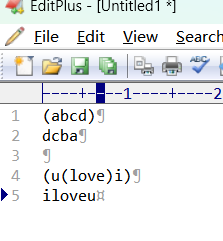反转括号中的字符串
反转括号中的字符串
题目描述

反转括号中的字符串,并返回没有括号的结果值。
题解
#include <iostream>
#include <stack>
using namespace std;
string helper(const string& s) {
stack<string> strs;
string res = "";
for (int i = 0; i < s.size(); ++i) {
if (s[i] == '(') {
strs.push(res);
res = "";
}
else if (s[i] == ')') {
string tmp = strs.top();
strs.pop();
reverse(res.begin(), res.end());
tmp += res;
res = tmp;
}
else {
res += s[i];
}
}
return res;
}
string analysis(const string& s, int& index) {
string res = "";
while (index < s.size()) {
if (s[index] == '(') {
string tmp = analysis(s, ++index);
reverse(tmp.begin(), tmp.end());
res += tmp;
}
else if (s[index] == ')') {
break;
}
else {
res += s[index];
}
++index;
}
return res;
}
int main() {
int idx1 = 0;
int idx2 = 0;
int idx3 = 0;
string s1 = "(u(love)i)";
string s2 = "(abc)";
string s3 = "(c(ba(ac))d)";
cout << helper(s1) << endl; // iloveu
cout << helper(s2) << endl; // cba
cout << helper(s3) << endl; // dbacac
}
思路
栈实现
- 使用一个栈来暂存上一层的的结果。
- 当遇到 '(' 时,就将这一层处理的字符串 res 放入栈中,并置空 res,用于下一层的处理。
- 当遇到 ')' 时,就弹出上一层的结果,然后转置这一层处理的字符串,将上一层的结果和转置后的字符串拼接,作为上一层的继续处理字符串,也就是上述代码中的 res。
递归实现
- 当遇到字符时,就是递归的基本情况是给 res += s[i];
- 当遇到 '(' 时递归调用,返回的结果进行转置,并拼接到 res 上。
- 当遇到 ')' 时,结束递归,并返回。




【推荐】国内首个AI IDE,深度理解中文开发场景,立即下载体验Trae
【推荐】编程新体验,更懂你的AI,立即体验豆包MarsCode编程助手
【推荐】抖音旗下AI助手豆包,你的智能百科全书,全免费不限次数
【推荐】轻量又高性能的 SSH 工具 IShell:AI 加持,快人一步
· 阿里最新开源QwQ-32B,效果媲美deepseek-r1满血版,部署成本又又又降低了!
· 开源Multi-agent AI智能体框架aevatar.ai,欢迎大家贡献代码
· Manus重磅发布:全球首款通用AI代理技术深度解析与实战指南
· 被坑几百块钱后,我竟然真的恢复了删除的微信聊天记录!
· 没有Manus邀请码?试试免邀请码的MGX或者开源的OpenManus吧